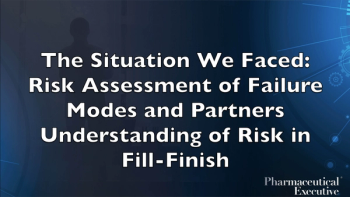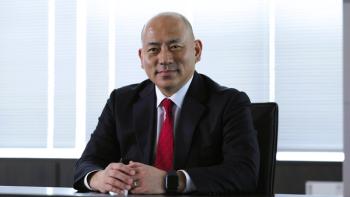
- Pharmaceutical Executive-11-01-2016
- Volume 36
- Issue 11
Flipping the Generics Map: Apotex's Jeremy Desai
Pharm Exec sits down with Jeremy Desai, CEO of Apotex, Canada’s largest producer of generic drugs, to discuss the local impact of mounting pricing pressure-and how smaller and independent companies can survive in an era of consolidation and growing competition.
Jeremy Desai, CEO of Apotex, Canada’s largest generic drugs producer, discusses the impact of industry pricing pressure in Canada-and how smaller and independent companies can thrive in an era of consolidation and growing competition
Apotex, founded with two employees in 1974, is now Canada’s largest producer of generics drugs, with a global staff of more than 10,000 and worldwide sales of more than CAD2 billion per year. Dr. Jeremy Desai joined
the company in 2003 as senior vice president of research and development, and later served as global head of R&D and chief operating officer. He was appointed chief executive officer and president in August 2014.
As the industry is under increased pressure on its pricing practices-from large-company consolidation and from the shift toward developing more complex biologics-Desai recently gave Pharm Exec his take on how a privately owned company like Apotex can survive in a changing and uncertain generics landscape.
PE: What are the key changes you have seen in the generics space-in Canada and beyond-since you joined Apotex?
DESAI: The competition has greatly increased over the last 15 years, that is from both Indian and Chinese companies moving into the arena. The regulatory rigor, especially from FDA-but not exclusively from that agency-has been enhanced. Over this period, we’ve gone from a position where there were many blockbuster, branded molecules available for genericization to one where we’re moving to more complex molecules, different dosage forms and to biosimilars. The other thing is the consolidation at the customer level. In the US today, four customers control almost 90% of the generic volume.
Competition in Canada has also increased and we’re seeing more what we call “suitcase companies.” These are generally the Indian companies, because for them it is a question of doing one Canadian biostudy to get an approval and then coming in and being able to compete solely on price at a time when the lens on pricing is becoming more focused.
PE: How can the industry adapt to this tougher pricing environment?
DESAI: It is a big problem for us in Canada because of the difference in the litigation landscape and the patent linkage compared with say, the US, where there is no 180-day exclusivity provision. There is no reward for a company taking on all that litigation, risk and cost in Canada, and so as pricing drops, it is difficult for us to maintain a sustainable model that undertakes these costs. And there lies the other problem, in that we have the double jeopardy law in Canada, where one can win in the courts on the regulation and launch, but lose on the patent trial and still be liable for lost profits from the brand.
Starting up now would be very different here. Apotex and the other Canadian companies that emerged in the late 1970s did so because of compulsory licensing; bringing generic medicines to the market was a much more regulatory-friendly process. But now, for a host of reasons, it’s a tough environment in Canada and if were to rewind the clock, it would be difficult to get the level of growth and traction in the market place that we did in the 1970s and 1980s.
PE: You’ve had a couple of recent clashes with Health Canada. What is the issue for you there?
DESAI: In terms of resources, Health Canada is relatively small in comparison with EMA (European Medicines Agency) or FDA and so, whether we’re talking about compliance or reviewing ANDAs (abbreviated new drug applications), we find that Health Canada tends to gravitate either to the European or the US position on approval. But it’s hard to predict which way it will go; there seems to be no rhyme or reason as to which system it chooses to support.
As we move into more complex issues, whether that is to do with more complex molecules or complex issues relating to compliance, we have to wait for Health Canada’s skill set to build. Historically, Apotex is one of the leaders in submitting these types of products, so we are always ahead of that learning curve with Health Canada. Our portfolios generally are driven by US and European patent expirations and more often than not, those happen earlier than in Canada, so our development is more advanced than Health Canada’s.
PE: Looking beyond Canada, what are your thoughts on the proposed EU-Canada Comprehensive Economic and Trade Agreement with Canada (CETA)?
DESAI: We lobbied hard as a generic association on trying to get the right language into the CETA agreement as it pertains to generics, and especially as it relates to data exclusivity, with the ultimate hope to remove the dual litigation provision in Canada. Some of that language was built into the final version, but with the new Trudeau government, a lot of that language is being discussed again. And now with Brexit, I don’t really know how CETA will unravel.
PE: Are emerging markets still an attractive option in your view?
DESAI: Emerging markets are attractive, but based on our experiences and those of other companies, we have to tread carefully. There is opportunity, no question, but the overall pharma growth of the emerging markets has been slower than expected. There are some unique characteristics, especially in some of the established emerging markets such as Latin and South America, that require specific strategies to be successful; they need to be driven on an access-driven commercial model as opposed to a simple sales and marketing focus.
From our point of view, we are evaluating where we are and making sure that we are sensitive to local competition and the increased foreign competition, but if we have the right portfolio and capabilities and understanding, there is still value to be gained from emerging markets.
PE: Is the wave of consolidation among big companies in the generics space something that concerns you?
DESAI: Consolidation, especially between the big manufacturers, has its own challenges, in terms of integration and bringing together different cultures, and therein lies considerable disruption. Customers still need to rely on companies of Apotex’s size to ensure that, as these larger companies go through their integration processes, they are not affected too much by the disruption.
The size of Apotex allows us to be much more nimble when looking at opportunities in the market. When other competitors, for whatever reasons, cannot supply products, we can move a lot quicker than some of the larger organizations because we don’t have the bureaucracy and levels of decision-making that some of these organizations have. We are privately owned, and consequently have more stability, and more continuity of knowledge and experience
Having said that, we continue to look at what our differentiation strategies are. Effective partnering is very important for us, as we still want to offer the broadest and most attractive portfolio and, of course, we can’t do everything internally. For us it remains important to find effective partners that can operate at the same level of nimbleness as we do.
PE: What strategy do you have with regard to developing and manufacturing more complex biologics?
DESAI: We’ve been very effective developing a pipeline almost under the radar-we haven’t made a lot of noise out there in terms of what we’ve been doing. Just recently, we were successful in a trial in the US against Amgen on Neupogen and Neulasta on non-infringement on a patent that was going out to 2031, and we are the first company to have won on that patent.
Our strategy on biosimilars has been very controlled; we haven’t gone in and acquired large companies or capabilities. We used almost a virtual model, where we’ve identified select partners in the development and the manufacturing arenas. Through that network we’ve been able to develop the first wave of products (the biosimilars of Neupogen and Neulasta) and we are now in the advanced stages of our second wave, which are monoclonal products.
We’ve also taken a position to focus on the oncology space, but rather than say, “OK, let’s do a biosimilar of Remicade or Humira,” we’re very much building our core competence internally and through our partnerships.
PE: Does investing in more complex medicines with longer development and manufacturing lead times and higher risks require a degree of cultural change?
DESAI: I don’t think it has required a cultural change, but it has required a change in terms of the skills we have had to develop and bring in. The skill sets that we’re now seeing in big biotech, small, start-up bio and companies developing biosimilars are converging. What we have had to do is reexamine the competencies that are needed, competencies that historically we have not required before.
PE: Is the biosimilars “pie” big enough for all companies to benefit from this potential market?
DESAI: We recognize that even in our own pipeline, the chances of being first on each of those molecules is low. However, we’ve developed very good science and our litigation strategy is quite unique, which was borne out by that successful Neupogen/Neulasta win in the US courts. While in some cases our development may be behind some of the companies
developing the same molecule, that doesn’t automatically mean we won’t be part of wave one, as there is the long patent dance in the courts and the obtaining of regulatory approval to take into consideration. So we hope that we will be a significant player in the first-wave launches of a particular molecule.
Our future growth rests on making sure we have a balanced portfolio and recognizing that some of the bigger opportunities going forward are going to be in complex dosage forms, maybe in CR, XR, and in different delivery platforms. But there is still immense value in making sure that we are one of the first-wave launches of small molecules coming off patent. Those numbers may be smaller, but we have to be there.
Julian Upton is Pharm Exec’s Online & European Editor. He can be reached at
Articles in this issue
about 9 years ago
Pharm Exec's 2017 Pipeline Reportabout 9 years ago
Digital Disruption is Coming: Are You Ready?about 9 years ago
8 Winning Commercial Portfolio Strategiesabout 9 years ago
Building Market Access Competencies for the Futureabout 9 years ago
Loss of Exclusivity: Strategies to Maximize Product Valueabout 9 years ago
The Pipeline: Pressures from Beyondabout 9 years ago
Has Gastein Peaked?about 9 years ago
Country Report: Switzerlandabout 9 years ago
Pharmaceutical Executive, November 2016 Issue (PDF)Newsletter
Lead with insight with the Pharmaceutical Executive newsletter, featuring strategic analysis, leadership trends, and market intelligence for biopharma decision-makers.




